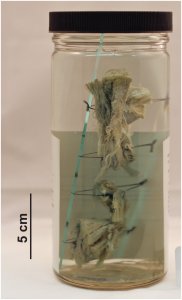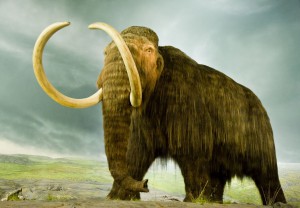I remember one particular encounter with “mystery meat” when I was in college. I was walking along the serving line at the dining hall, and when I came to the entrée, I asked the server, “What is it?”
She replied quite succinctly, “Don’t know. Got beef in it.” I passed on the entrée that night, settling for salad and bread.
I would probably not have be a good candidate for membership in the Explorers Club.
The Explorers Club, founded in New York City in 1904, is a professional society that champions the cause of field research (1). The member list is impressive, including Teddy Roosevelt, the American President responsible for setting aside many of the most treasured public lands in the United States so that explorers have fields for research and wild places for adventures, Neil Armstrong, the first man to set foot on the moon, and Don Walsh and Jacques Piccard, the two men who descended into the Mariana’s trench to explore the deepest part of the ocean, among others.
In addition to a membership list that reads like a who’s who of science and exploration, The Explorers Club also has an annual dinner that for many years has popularized a menu of “exotic” foods (at least exotic foods from the point of view of the typical Midwest United States pallet). One of the club’s most celebrated dinners took place on January 13, 1951.

Division of Vertebrate Zoology, YPM HERR 19475. Courtesy of the Peabody Museum of Natural History, Yale University, New Haven, CT, USA. doi:10.1371/journal.pone.0146825.g002
This meal was catapulted into the public imagination by an article in The Christian Science Monitor (2), which reported that the members dined on a meal of mammoth provided by the Rev. Barnard Hubbard (i.e., the “Glacier Priest”) from his own private stock of frozen wooly mammoth meat from Akutan Island. According to the article, the unusual dinner also included tremendous boiled Pacific spider crabs, each leg of which would feed ten people, and a glass with a chunk of ice purportedly from a glacier.
Interestingly though, perhaps in the spirit of curation and preservation of history, several pieces of the meat served at this dinner were preserved and placed in a museum by Paul Griswold Howes who was an Explorers Club member unable to attend the annual dinner that year. The samples of the meat were provided to him by Commander Wendell Phillips Dodge who was the annual dinner chairperson. And perhaps even more interesting, Dodge identified the meat for the museum specimen not as mammoth, but rather as something much rarer, the extinct giant ground sloth (3).
![Geographic ranges of potential source taxa for the 1951 ECAD meat supposedly discovered on Akutan Island, AK, USA. Ranges are overlaid on a map of modern North and South America. Colored circles represent fossil localities: blue, woolly mammoth (Mammuthus primigenius); red, Megatherium; yellow, non-Megatherium fossil sloths. Green area represents modern range of green sea turtle (Chelonia mydas). Fossil specimen locality data were obtained from FAUNMAP II [51] and the Paleobiology Database (www.paleobiodb.org). The green sea turtle (C. mydas) range follows [25].](https://www.promegaconnections.com/wp-content/uploads/2016/02/journal.pone_.0146825.g003-208x300.png)
Geographic ranges of potential source taxa for the 1951 ECAD meat supposedly discovered on Akutan Island, AK, USA.
If the meat were indeed, ground sloth, it would expand the range of this genus, which is known only from South America over 600% and completely transform what we think we know about ground sloth evolution (3). However, there is also evidence Dodge deliberately misled Howes, based on a tongue-in-cheek editorial he wrote shortly after the dinner in which he basically said that he may have discovered a “potion” for turning sea turtle from the Indian Ocean into the Giant Sloth from the Pit of Hades in the Aleutians (3).
To determine the identity of the mystery meat served at the annual dinner, Glass and colleagues from Yale University explored the new frontier of ancient DNA. They extracted DNA from the preserved meat before amplifying a section of the cytochrome B gene from mitochondria using universal vertebrate primers that was used for sequence comparison to sequences available in public databases for related species.
What they determined is that the sample preserved so carefully in the museum was not mammoth. Nor was it giant sloth. It was indeed, sea turtle, probably meat from the same turtle soup served that night.
References
- Nichols, H.B. (1951) Mammoth Appetites Explore a…Mammoth. The Christian Science Monitor Jan 17. page 3.
- Glass, J.R. et al. (2016) Was frozen mammoth or giant ground sloth served for dinner at the Explorers Club? PLOSOne 11(2): e0146825
- Explorers Club website https://explorers.org/ [Internet: Accessed February 15, 2016]
Special Note: GoTaq polymerase was used in the amplification of cytochrome b gene from the museum sample in this paper.
Michele Arduengo
Latest posts by Michele Arduengo (see all)
- An Unexpected Role for RNA Methylation in Mitosis Leads to New Understanding of Neurodevelopmental Disorders - March 27, 2025
- Unlocking the Secrets of ADP-Ribosylation with Arg-C Ultra Protease, a Key Enzyme for Studying Ester-Linked Protein Modifications - November 13, 2024
- Exploring the Respiratory Virus Landscape: Pre-Pandemic Data and Pandemic Preparedness - October 29, 2024


Funny. I’ll never forget my first international conference as a grad student. It was in Holland and every day as part of the conference meal plan we were served a different sort round of slab of meat, obviously cut from a formed loaf. The joke between me and my fellow Americans was that is was ‘mystery meat’. Much later in life, soon after moving to Australia, I had a similarly memorable experience of looking for a snack at a beach kiosk. They had meat pies. When I asked what kind of meat, I was simply told “It’s meat, mate”. I passed!
I probably would have passed as well on the unknown meat that had set in the sun all day on the beach too!
Sorry, but the chain of custody throws some doubt on the results. Could be they did have mammoth (or even less likely, sloth) at the dinner, but Commander Dodge, shown by his own comments here to be an unreliable witness, kept any leftovers for himself and shipped out some turtle to his friend. And so the plot thickens…or maybe just the soup.
Well, I don’t know if the soup thickened or not. If the meat was “repurposed” for the main course, it might have been rather “soupy” indeed.